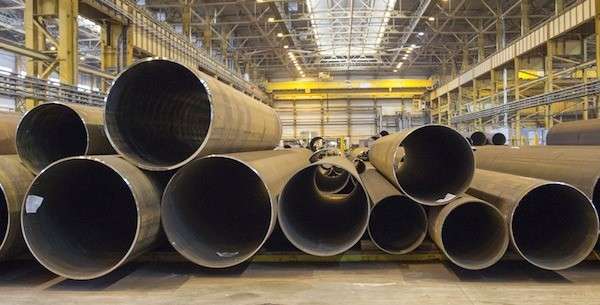LSAW (Longitudinal Submerged Arc Welded) and SSAW (Spiral Submerged Arc Welded) pipes are both types of submerged arc welded pipes that are used in a variety of applications, including oil and gas pipelines, water and wastewater pipelines, and construction projects. However, there are some key differences between the two types of pipes.
LSAW Pipe Manufacturing Process
- LSAW pipes are made by rolling a steel plate into a cylinder and then welding the longitudinal seam. This process produces a pipe with a straight seam that is strong and durable.
SSAW Pipe Manufacturing Process
- SSAW pipes are made by rolling a steel strip into a spiral and then welding the spiral seam. This process produces a pipe with a spiral seam that is more flexible than a straight seam, but it is also not as strong.
Applications
LSAW Pipes:
Longitudinal Submerged Arc Welded (LSAW) pipes are chosen for applications demanding high strength and durability due to their robust construction. They are particularly well-suited for the following purposes:
- Oil and Gas Pipelines: LSAW pipes are a go-to choice for constructing oil and gas pipelines. Their ability to withstand high-pressure environments, combined with their strength, ensures the safe and efficient transportation of hydrocarbons over long distances. They are a crucial component of the energy infrastructure, supporting the global supply of oil and natural gas.
- High-Pressure Water Lines: When the transportation of pressurized water is necessary, LSAW pipes excel due to their ability to maintain structural integrity under high pressure. This makes them suitable for water supply networks, hydroelectric projects, and industrial water distribution systems.
- Infrastructure Projects: LSAW pipes are utilized in various large-scale infrastructure projects, such as bridges and tunnels, where the structural integrity of the pipes is paramount. Their durability and strength ensure the longevity and safety of these critical structures.
SSAW Pipes:
Spiral Submerged Arc Welded (SSAW) pipes are preferred when flexibility is prioritised over sheer strength. They are particularly well-suited for applications that require adaptability and resistance to ground movement:
- Water and Wastewater Pipelines: SSAW pipes are ideal for transporting potable water, wastewater, and stormwater. Their flexibility allows them to navigate the contours of the terrain, making them an excellent choice for water distribution in urban and rural areas. They can accommodate ground settling or shifting without compromising the pipeline’s integrity.
- Culverts: Culverts, essential for managing water flow under roads and railways, often use SSAW pipes. Their flexibility allows them to adapt to the changing ground conditions and potential settlement, ensuring the longevity and efficiency of these drainage structures.
- Foundation Piles: In construction projects where the ground is not entirely stable, such as in coastal regions or marshy areas, SSAW pipes are used as foundation piles. Their flexibility makes them well-suited for withstanding lateral forces and ground movement while providing structural support.
Advantages
LSAW Pipes
- Higher strength and durability
- Straight seam is easier to inspect
- Typically used for larger diameter pipes
SSAW Pipes
- More flexible
- Less material waste during manufacturing
- Typically used for smaller diameter pipes
Disadvantages
LSAW pipes
- More expensive to manufacture
- Straight seams can be more difficult to weld
- Typically not used for smaller diameter pipes
SSAW pipes
- Lower strength and durability
- Spiral seam is more difficult to inspect
- Typically not used for larger diameter pipes
Choosing the Right Pipe
The project’s particular requirements will determine which kind of pipe is best for a given application. If durability and strength are the most crucial considerations, an LSAW pipe is a wise option. If flexibility is more important, then an SSAW pipe is a better option.
Here is a table summarizing the key differences between LSAW and SSAW pipes:
| Feature | LSAW Pipe | SSAW Pipe |
| Manufacturing process | Rolled and welded longitudinally | Rolled and welded spirally |
| Seam type | Straight | Spiral |
| Strength | Higher | Lower |
| Flexibility | Lower | Higher |
| Typical applications | Oil and gas pipelines, high-pressure water lines | Water and wastewater pipelines, culverts |
| Advantages | Higher strength and durability, easier to inspect | More flexible, less material waste |
| Disadvantages | More expensive to manufacture, more difficult to weld | Lower strength and durability, more difficult to inspect |
I hope this blog post has helped you to understand the key differences between LSAW and SSAW pipes. If you have any further questions, please feel free to leave a comment below.
For more information visit – lsaw pipe manufacturers in india










